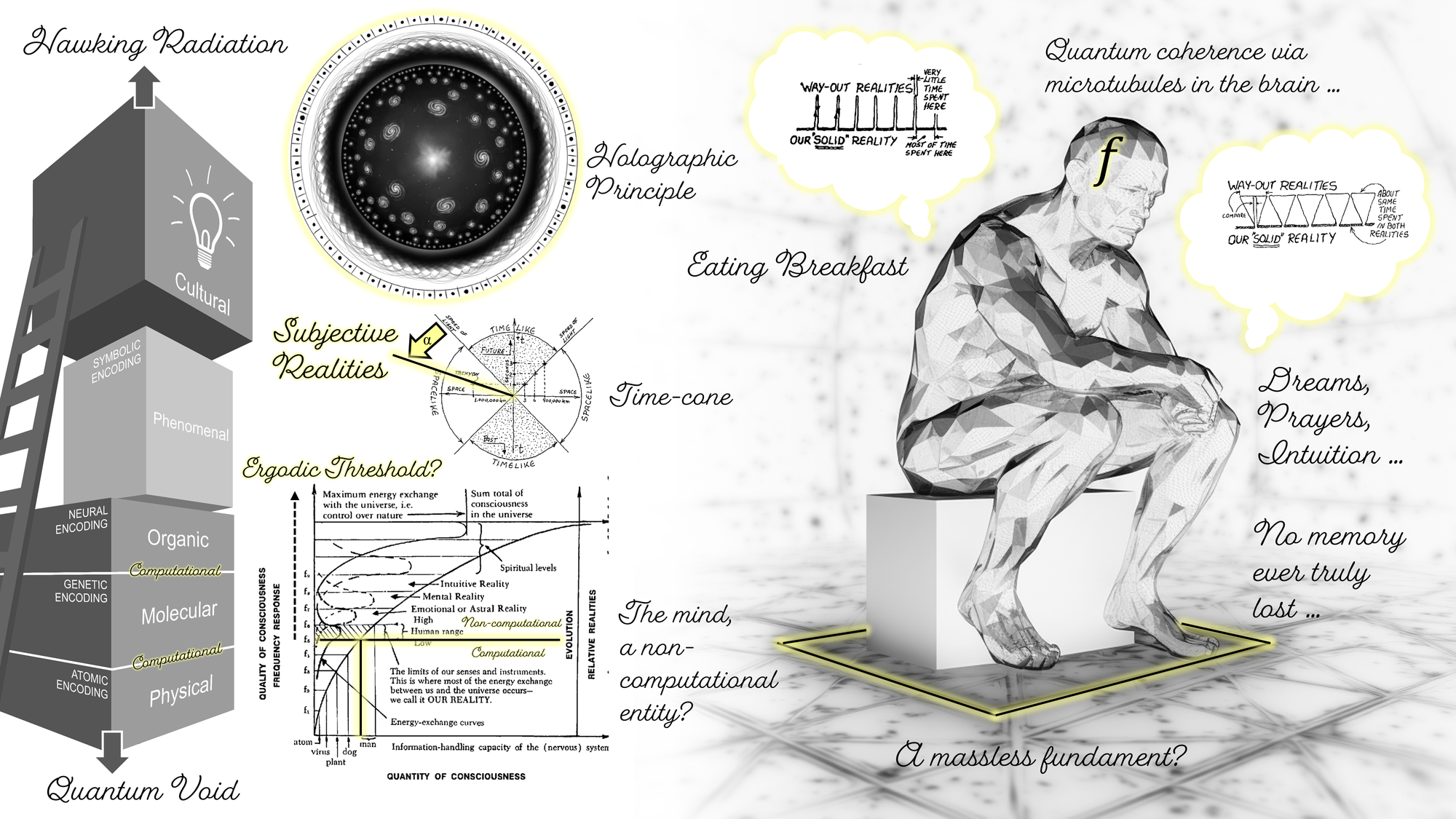The Frequencies of Dreams, Intuition & Meditative Prayer?

I've always been held captive by the idea that there's more to reality than what we perceive directly through our ‘normal senses’. Recent research by Dr Philip Kurian at the Guy Foundation (a nice YouTube video also) and other adjacent studies, such as ORCH theory by Penrose and Hameroff, suggests that there is indeed scientific substance behind such a hunch. It's like we're looking through a tiny window, seeing only a narrow slice of a vast spectrum. Sometimes, though, we get glimpses of what's beyond that window—through dreams, intuition, and prayer. It seems that there is a demarcation between the ergodic nature of meta-cognition and the non-ergodic reality of our baryonic reality (as explored in past articles). If informational loss is minimal and information about the system is maximal, entropy is minimised. However, it seems that our consciousness behaves differently, it seems to cross this “ergodic threshold” and behave non-computationally, which is the topic explored in this article.
These non-conventional experiences feel different from our everyday consciousness. They seem to operate on different frequencies, tapping into layers of reality that aren't normally accessible. But what does that mean, exactly? And can we partly appreciate it through our rational faculties? Let's recap some physics to help unpack this notion a little...
The physicist Rolf Landauer was one of the first to make this linkage between matter, energy and information explicit. In 1991, he declared that information is physical. This wasn't just a philosophical statement. He showed that erasing information has a physical cost—it generates heat. This ties information directly to thermodynamics, the branch of physics that deals with energy and entropy.
Entropy is often described as disorder, but a better way to think of it is as a measure of uncertainty or lack of information. When you have complete information about a system, its entropy is low. As information disperses, entropy increases. This isn't just a poetic way of speaking. The equations that describe entropy are the same whether you're talking about heat spreading out in a room or information spreading out in a network. I‘ve found this a useful notion to ponder whilst trying to contemplate the mind-bending significance of omnipresence (e.g. Acts 17:28 etc). But this depends on one‘s own worldview of course.
This connection between information and entropy has profound implications. It suggests that time itself might be understood as the flow of information. As entropy increases—as systems evolve from order to disorder—information spreads out. The arrow of time, which has always been a bit of a mystery in physics, becomes a manifestation of informational flow.
The prolific inventor and scientist, Itzhak Bentov, in his book Stalking the Wild Pendulum, offers an interesting perspective. He suggests that our consciousness isn't static but fluctuates, oscillating between different states. He talks about how our brains and bodies are like oscillators—systems that move back and forth in a rhythmic fashion. On a fundamental level, our bodies are are composed of quantum harmonic oscillators - informational fields that oscillate between two states of rest. This movement isn't just physical; it also implies a shift in consciousness.

Think about dreams. When we dream, our brains produce different types of brainwaves than when we're awake. We're literally operating on a different frequency. Interestingly, in scriptures, it states in Numbers 12:6 that God chose to reveal himself to his prophets through dreams and visions. In this state, it seems the usual constraints of time and space seem to loosen significantly. We can essentially experience events that defy the conventional laws of time and causality.
Intuition feels similar. It's that sudden knowing that doesn't come from a linear thought process. We're not reasoning our way to an answer; it just appears. Sometimes, it feels like the answer comes from outside us, but perhaps it's more accurate to say it comes from a deeper part of us. Again, it's like tuning into a different frequency, one where information is processed in a non-linear way.
Meditative prayer is another example. When people pray, they're often seeking a connection with God, a contemplative “feeling around” (Acts 17:26-27) whilst in a prayerful state of mind. This isn't just about words or thoughts; it's about a state of being. In prayer, people might feel a sense of peace or transcendence. They might feel they're in touch with a higher reality. Whether or not you believe in a deity, there's something to be said about the mental state that prayer can induce. It's another shift in consciousness, another frequency.
The idea of different frequencies of consciousness makes me think of the Māori word for autism: takiwātanga. It comes from the phrase "tōku/tōna anō takiwā," meaning "my/his/her own time and space." It's a beautiful way of expressing that someone might experience reality differently, inhabiting their own time and space. We are all authors of our own subjective time-cones it seems.
“Since human minds are constructing our physical theories, why speak of objective rather than subjective reality? Recall the repeatability of experiments and the predictive power of theories. I have mentioned examples from a century ago, more to be discussed in this book are drawn from the relativistic theory of physical cosmology, and a still broader variety is to be found in other branches of physical science. They are the basis for the argument that our well-tested theories are useful approximations to the operation of a lawfully operating objective reality. We cannot do better; there cannot be a proof of objective reality from natural science.” – P. J. E. Peebles (The whole truth: a cosmologist's reflections on the search for objective reality)
Bentov's ideas remind me of passages from the Bible, like Job 38:36 and Psalm 51:6. In Job, God asks, "Who has put wisdom in the inward parts? Or who has given understanding to the mind?" It's a recognition that there's an inner wisdom, a deeper understanding that isn't always accessible through conscious effort. In the Psalm, the writer says, "Behold, you desire truth in the inward parts: and in the hidden part you shall make me know wisdom." Again, there's this theme of inner knowledge, of truths that are hidden but can be revealed. In my own emergent journey of faith, I wrestled with verses such as Psalm 139:2-4 and Psalm 139:16 - since they suggest that this “fundament” is like a film-roll (or “Book of Life” as the bible calls it in Phil 4:3) that captures all thoughts and experiences in our universe.
What this “fundament” is, is anybody’s guess, but the closest hook that I currently hang my thoughts on are Hilbert spaces. Hilbert spaces (central in quantum mechanics) can be visualised as lower-dimensional surfaces that encode higher-dimensional dynamics (detailed a bit in a past article). This resonates with the Holographic Principle’s key notion that the physics in a volume of space can be fully described by information on a boundary surface, as noted in the feature image.
So how do we tap into these truths which fall outside of our computational spacetime? Our minds are truly mysterious, and like Sir Roger Penrose and Stuart Hameroff, I believe that the quantum nature of the mind yields it a non-computational nature (as alluded by Kurian’s fascinating research https://doi.org/10.1126/sciadv.adt4623). If time is a manifestation of informational flow, then perhaps, time either vanishes or becomes more liquid when information flows outside the boundary conditions of computation. Dream states can often feel timeless, and perhaps it's about being open to experiences that don't fit neatly into our "rational frameworks".
Quantum physicist Seth Lloyd praised Kurian’s work, highlighting that the computational abilities of living systems are far more advanced than those of artificial systems. These findings emphasize the incredible processing power inherent in life itself.
“In the era of artificial intelligence and quantum computers, it is important to remember that physical laws restrict all their behaviors,” Kurian said. “And yet, though these stringent physical limits also apply to life’s ability to track, observe, know, and simulate parts of the universe, we can still explore and make sense of its brilliant order as the cosmic story unfolds. It’s awe-inspiring that we get to play such a role.” Source: https://www.techexplorist.com/quantum-biology-redefines-lifes-computational-limits/98483/
In a way, it's about stepping into our own time and space, like the concept of takiwātanga. It's recognising that reality is multidimensional and that our consciousness has the capacity to move between these dimensions. We're used to navigating the physical world, perceiving what's directly in front of us. But there's a subjective reality that runs deeper, one that's shaped by our thoughts, feelings, and states of consciousness. Pierre Teilhard de Chardin, a French philosopher and Jesuit priest, had a vision of the universe evolving toward increasing complexity and consciousness. He coined the term "noosphere" to describe the sphere of human thought encircling the Earth, emerging from the biosphere much as the biosphere emerged from the geosphere.
This doesn't mean abandoning rationality or empirical evidence. It's not about rejecting science or embracing superstition. Rather, it's about acknowledging that our perception of reality is paltry at best and that information can flow in yet-unknown ways.
When we consider dreams, intuition, and prayer as different frequencies of consciousness, we open ourselves to a more expansive view of reality. We start to see that the linear, material world is just one layer. Beneath it, or perhaps surrounding it, are other layers that we can access if we learn how to tune in.
It's like discovering that there's more to the spectrum than visible light. Just because we can't see ultraviolet or infrared doesn't mean they don't exist. Similarly, just because certain experiences don't fit into our usual perceptions doesn't mean they're not real.
The challenge is to find a balance—to remain grounded in the physical world while also exploring these other frequencies. It's about expanding our window onto reality without losing sight of where we are. Maybe that's what life's pilgrimage is all about: expanding our awareness, deepening our understanding, and finding connections between the seen and unseen.

